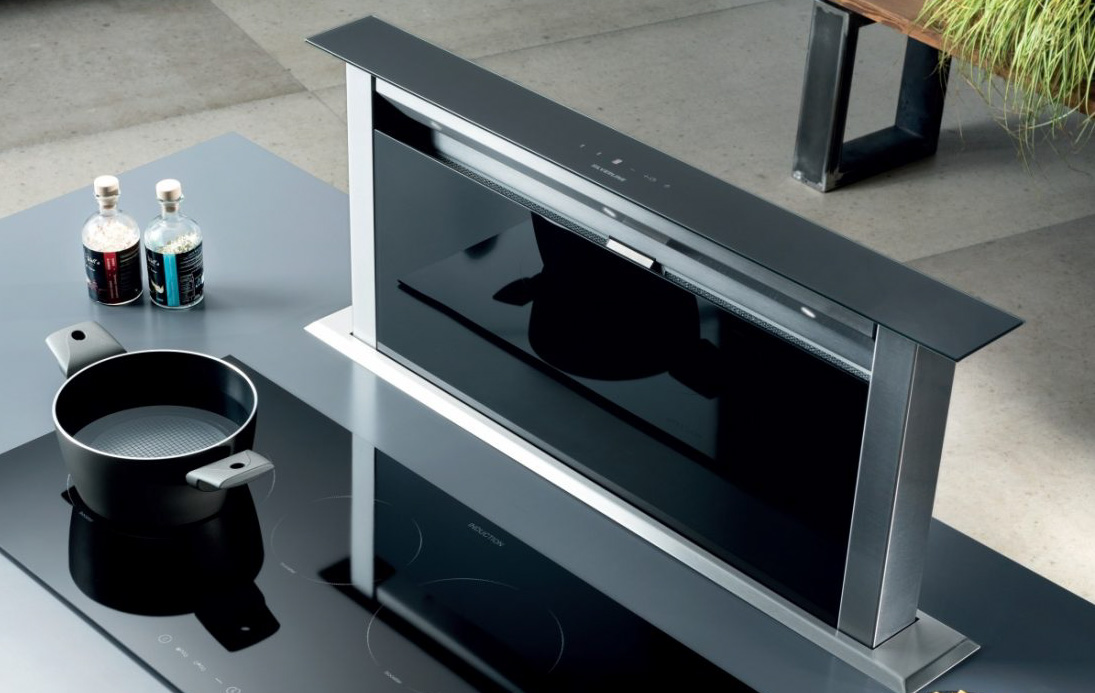
The layout of your kitchen will determine whether your rangehood can be mounted on a wall, incorporated into your cabinets, suspended from the ceiling or installed into your benchtop.
By that we mean that windows, ceilings, cooking on island unit or wall unit, and the position of your kitchen in relation to your home all contribute to what rangehood options you have available to you. This is where a kitchen designer’s experience is invaluable and will help with your options prior to design.
One of the main considerations is what option is more effective and less noisy.
In our experience remote motor options are always the quietest because the motor is positioned somewhere other than where it is extracting, so reduces the noise of the motor. Traditionally canopy hoods have always been the noisiest because the motor is positioned at head level so will be louder.
We find that a rangehood with only three speeds is generally speaking nosier as the extraction goes up in larger increments meaning it is all or nothing.
If you intend to go with a traditional canopy or island rangehood then look for something with more speed levels to combat the motor being at head height level or opt for the ones that offer remote motor options.
Ducting
Another important consideration is the ducting of your rangehood which is unfortunately often an afterthought. Builders tend to put in flexible ducting which has a significant impact on the flow and noise of a rangehood, especially if it is more of a technical design.
We are now seeing the kitchen industry taking particular care when planning kitchens making sure to discuss ducting with the homeowner at the design stage. Not many people know that you can achieve an extra 10-15% increase in flow and decrease in noise by using the right ducting for your rangehood. There are companies out there who specialise in just the installation of rangehoods and install rigid ducting to achieve this.
Extraction Rate
We have also seen consumers get smarter at interpreting what is marketing spin and specifications.
Years ago everyone just looked at extraction rates of rangehoods and compared extraction rates only. Now people are asking whether these are gross figures or net extraction figures.
Gross means what the motor is capable of extracting but not necessary what the rangehood extracts once it is installed. Whereby others market it as net rate, meaning what the rangehood can extract with the motor in it.
Types of Rangehoods
Integrated Rangehoods
The ultimate solution is the introduction of downdraft in the center of the cooking zone with a remote motor.
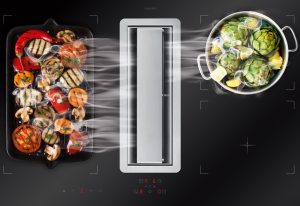
The Flow-In induction hob is a hi-performance extraction system that quickly removes the fumes from your cooking surface. Steam rises at one meter per second, the Flow-In extracts at four meters per second. This type of integrated rangehood works well for kitchen island cooking where an overhead option might not be practical.
The Flow-In allows for easy cleaning thanks to the detachable inner body.
Downdraft Extractors
Downdraft extractors are a perfect solution for kitchen layouts where you can’t duct up. Generally, these require a lot of room in the cabinetry below the unit for the motor unless purchasing a remote motor option. Also ideal for those who have windows behind their cooking space.
With a touch of a button, the extractor can be raised out of the benchtop when needed and provides a powerful extraction solution while creating a modern and uncluttered look.
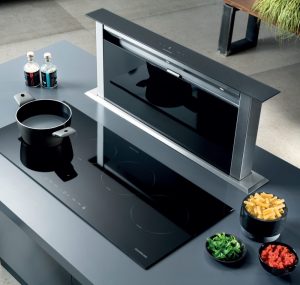
Downdrafts are often perceived as less effective which is not the case as it depends entirely on where the downdraft is located in relation to the cooking. The most effective rangehoods on the market, in our opinion, are the ones where the downdraft is positioned in the middle of the cooking area as it has to work less to extract fumes being positioned right at the source. In comparison, a canopy rangehood or ceiling rangehood have to work a lot harder to extract steam and cooking vapours in which case most people increase speed which in return increases the noise.
Ceiling Rangehoods
Installing your rangehood straight into your kitchen ceiling is a growing trend. With minimalism in mind, these type of rangehoods provide effective extraction power through targeted air extraction while taking up no additional kitchen space.
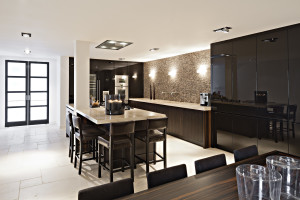
Some models can be used with a remote motor to minimise noise. Ceiling rangehoods are ideal for kitchen islands. These can be positioned up to three meters high, however, the higher you are from your cooking area, the less effective they are.
Ceiling rangehoods are currently one of the only viable options when you want a freestanding oven with cooktop with a window behind but don’t have enough wall cavity space for a canopy / wall unit. Make sure to always discuss your extraction options with your kitchen designer before purchasing.
Power Packs
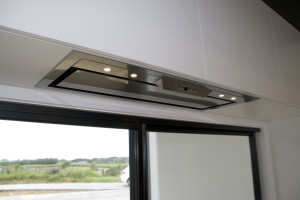
Power Packs are powerful built-in extractors that are installed directly into your cabinetry for a seamless, unassuming look. These are ideal when you want to ‘hide away’ the rangehood to create a streamlined look. Some models can be used with a remote motor to minimise noise.
Slide-Out / Retractable Rangehoods
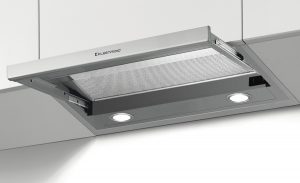
Slide-out rangehoods are real space savers and a great option if you have a narrow or small kitchen as they sit neatly underneath a cupboard and can pulled out when needed to eliminate steam and odours.
Traditionally, these have had low extraction and made excessive noise, however we are seeing newer models on the market with higher extraction rates.
Canopy Rangehoods / Wall Units & Island Rangehood
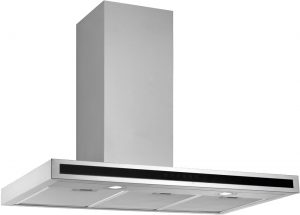
A canopy rangehood is a type of rangehood that forms a canopy over the cooktop and is usually made of stainless steel. These can be installed in the wall or can be installed into the ceiling. This type is effective and efficient however can be an eyesore.
Airflow Power
The airflow power required normally depends on the size of kitchen and type of cooking. The correct airflow for your specific kitchen can be easily worked out. Simply multiply the volume of the kitchen by ten and you will obtain the ideal airflow for that room.
For example, for a kitchen of 3m x 4m with a height of 2.7m: (3 x 4 x 2.7) x 10 = 324. In this case, any Ikon cooker hood with airflow equal to our superior to 324 m3/h will therefore guarantee the complete and efficient ventilation of the room. For a large family, for those who love cooking as an art, or where a group of friends are gathered together in a spacious kitchen to experiment with some exotic recipes, the hood capacity should be over 500 m3/h. Effective capture of cooking fumes also depends on the correct use of the product, where the product is mounted, what you are cooking and how and how the rangehood is ducted.
Types of Ducting – Ducted vs. Recirculated
Ducting a rangehood can be either ducted through the eaves, wall or roof. The ducted version will carry the steam, vapours and oils to the outside vent and remove them from the kitchen, whereas the recirculated version captures the air, purifies it through charcoal filters and sends it back into the kitchen environment.
Where possible we always recommend a rangehood is ducted as opposed to recirculated, however sometimes this is not possible. To duct a rangehood is always more expensive to begin with but nothing is required after the installation. However, with the recirculated versions, you do need to replace filters on a regular basis which becomes an ongoing cost and inconvenience to replace.
The ducted version must be connected to the outside through ducting that carries all the captured air from the house. This requires piping with a sufficiently large diameter at least 125mm (though 150mm is preferred). The piping must also not be too long or tortuous, otherwise the aerodynamic resistance of the passage can cause “power loss”, that is cubic metres of lost airflow.
Piping is not required for the recirculated version, since the captured air is purified through the rangehood’s active carbon filters and then returned to the kitchen environment. In this version it is extremely important to observe correct maintenance of the odour filters, and to replace them when necessary.
Most Ikon models are designed to work for both versions of ducting.
Remote Motor to Minimise Noise
The only way your rangehood can be silent is to have a remote motor. The noise of a rangehood comes from the motor located just inside your rangehood. You will always have some noise in a rangehood, which would be the actual air movement through the vents provided to extract, but it is significantly reduced with a remote motor.
The higher the extraction, the noisier your rangehood will be unless you remove the motor from its rangehood body and place it somewhere else in the house. Note, remote motors are brand specific.
Ikon has a large selection of rangehoods to choose from.

Some of our best selling rangehoods:
-
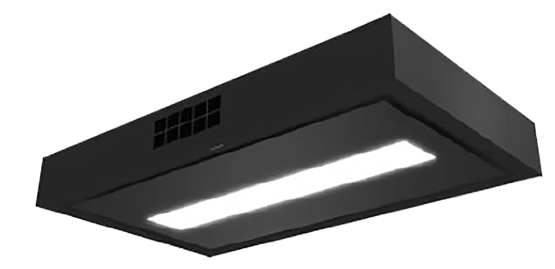 IK25B Ceiling Unit Black$3,399.00
IK25B Ceiling Unit Black$3,399.00 -
 IK47 (white) 60cm Power Pack$1,099.00
IK47 (white) 60cm Power Pack$1,099.00 -
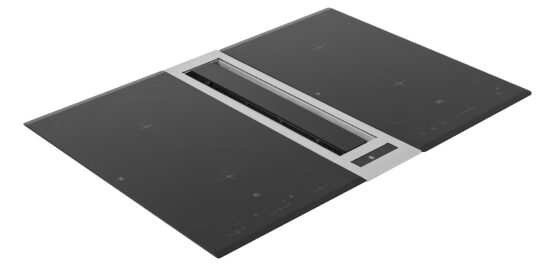 Double-Flow (3417)$4,799.00
Double-Flow (3417)$4,799.00 -
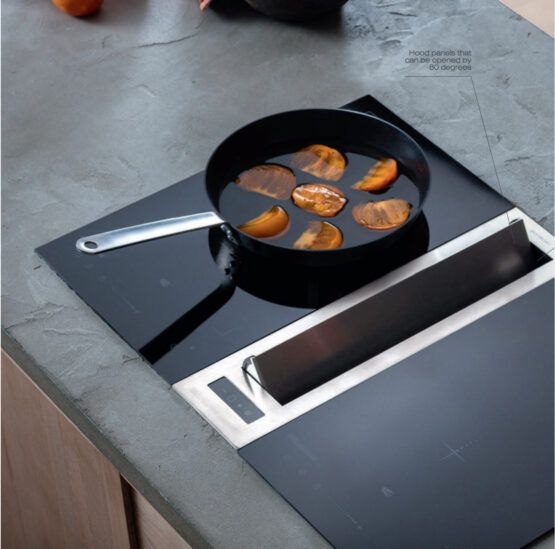 Free-Flow (3416)$4,799.00
Free-Flow (3416)$4,799.00 -
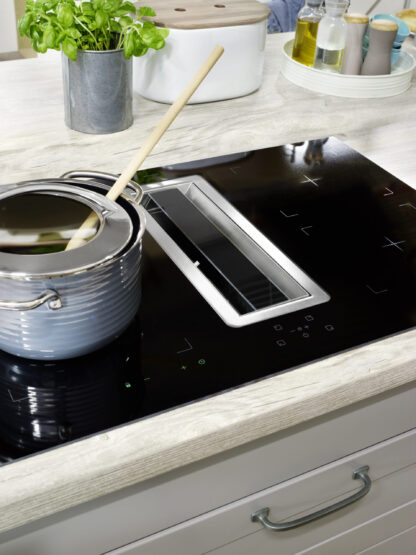 Flow-In 80cm (3413.2)$4,515.00
Flow-In 80cm (3413.2)$4,515.00 -
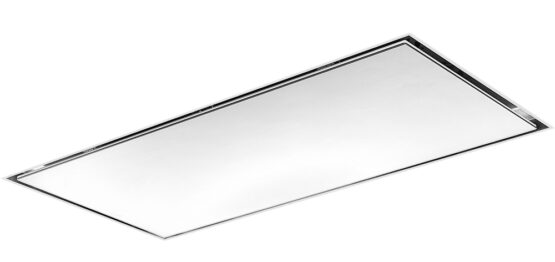 IK22 Ceiling Unit White$2,399.00
IK22 Ceiling Unit White$2,399.00
